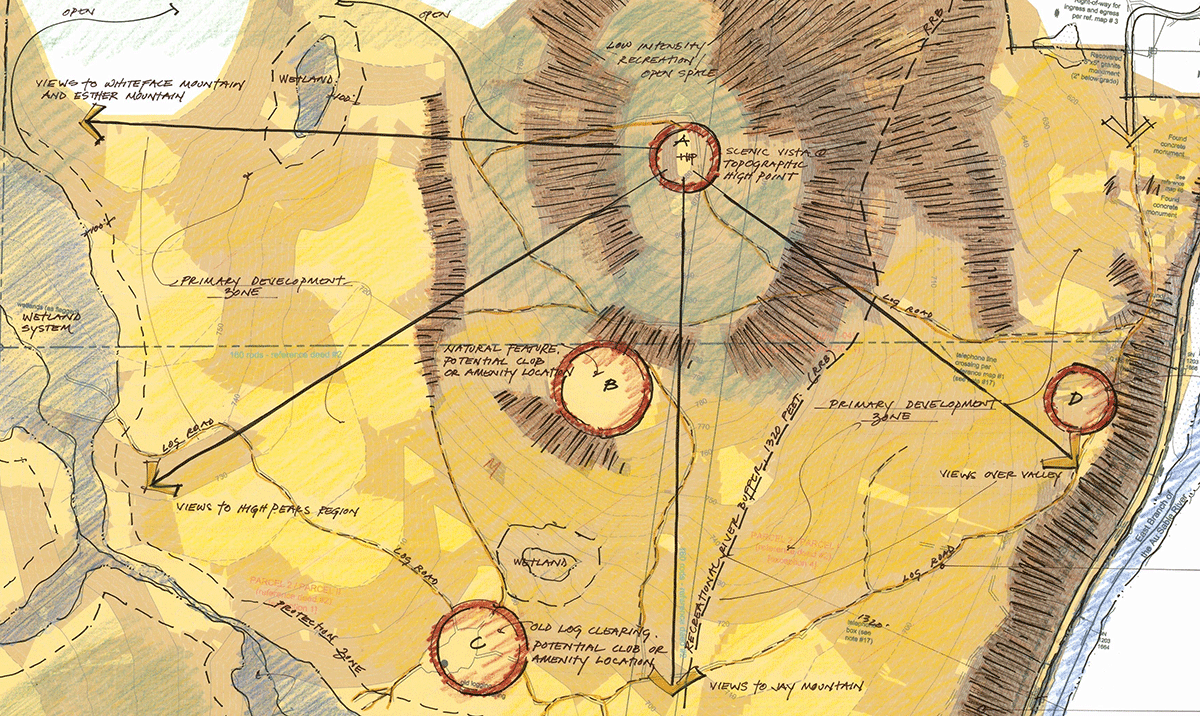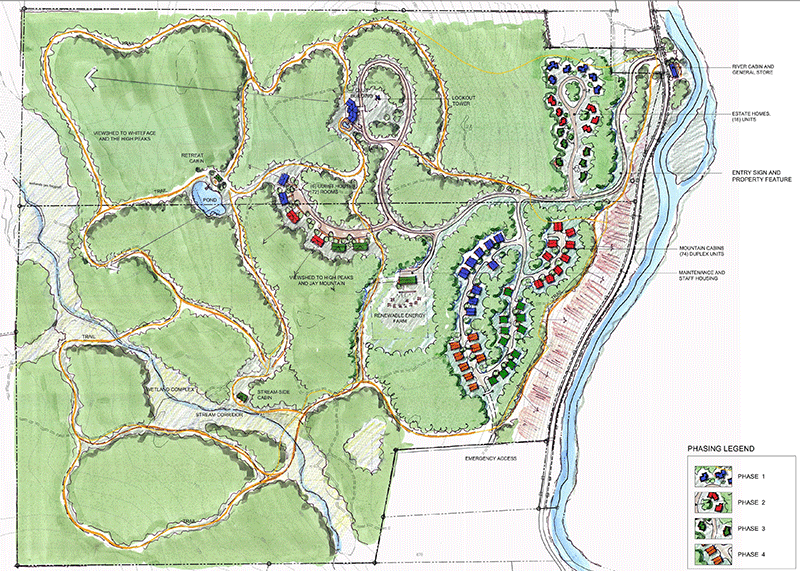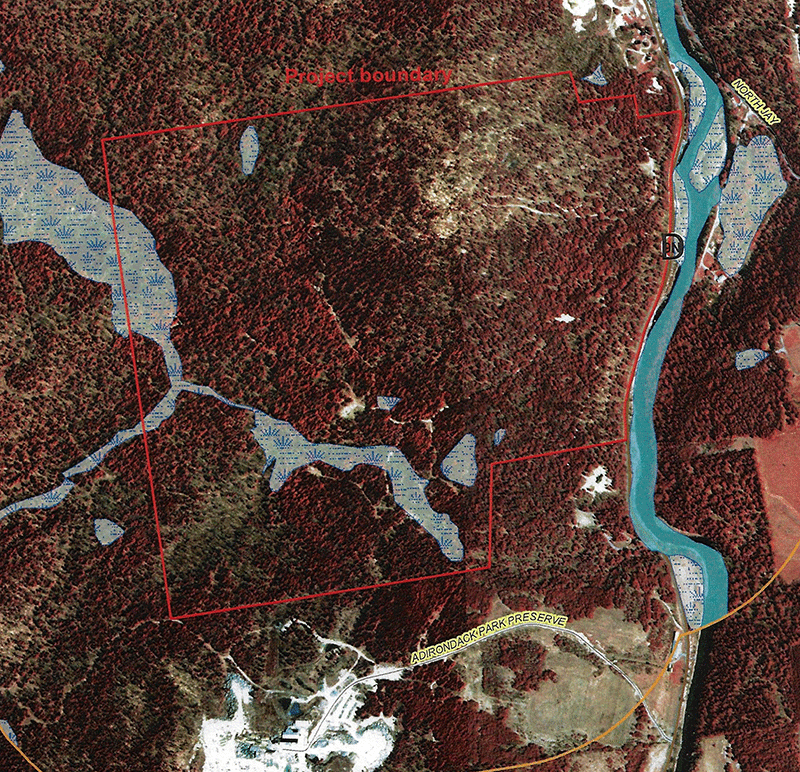Protect the Adirondacks has a number of concerns about the proposed new project submitted to the Adirondack Park Agency (APA) in the Town of Jay in Essex County by Eric Stackman, a land developer from Miami, Florida. This project is in the AuSable River Valley, across the Route 9N from the East Branch of the AuSable River. This project appears to be a textbook example of how to fragment and degrade an intact forest system.
The project (APA Project 2021-0248) involves the development of 355 acres of mostly intact forest with 120 residential buildings and over 1.2 miles of new road. These lands are classified as Low Intensity under the APA Land Use and Development Plan. This project appears to seek the maximum allowable number of buildings under APA guidelines for a Low Intensity Use Area.
The reality of this project is that these lands are basically an intact high canopy forest that has a history of forest management. The applicant proposes to undertake extensive forest clearing, road building, and housing construction that will change the ecology of these lands and the character of this part of the Town of Jay.
This project is the second project to undergo review according to the APA’s new Large-scale Subdivision Application, which is designed to bring greater scrutiny to big proposed subdivisions and to encourage conservation design practices to protect environmental resources on a tract of land. The APA Large-scale Subdivision Application states on page 1:
The application process is intended to encourage the development of projects in compliance with the Agency’s review criteria, including protection of open space, wildlife, and habitat resources, and in accordance with the objectives of conservation design.
The proposed Stackman development must be redesigned as a conservation subdivision or sent for a formal adjudicatory public hearing for review. This 355-acre tract has large portions that are simply not suitable for residential development. The project seeks to site new development on the east side of the property along the Route 9N corridor. Other buildings will be located in the center of the property. All buildings are connected by a new wide road network. There are 3 to 4 miles of trails that run are planned through northern, western and southern parts of this tract. The applicant proposes a modest solar farm and construction of a pond.
The applicant submitted two proposals and neither are conservation subdivisions. Conservation subdivision design is based on advancements in science and land use planning techniques that recognize that the spatial pattern of development is fully as, if not more, ecologically important than is its density. Widely scattered development, or “rural sprawl,” impairs ecosystem function, decreases biotic integrity, alters species behavior and composition, increases human-wildlife conflicts, fragments ownership, impairs cohesive land management, undermines the open space character of the Adirondack Park, and threatens its healthy timber industry. Conservation design yields more than ecological benefits. The development of just a portion of a tract requires less infrastructure to be provided by a developer and to be maintained by the local jurisdiction.
Each dwelling in a forested area has an ecological effect zone extending far beyond the immediate disturbed area of the site. Siting residential development so that ecological effect zones overlap results in a substantially lower total disturbance and concomitant benefits to the conservation of biodiversity.
The proposed site is just north of an active quarry site in an area classified as Industrial Use. This site may utilize blasting and is an active industrial site. We’re concerned about the long-term viability of a quarry when an exclusive private residential development is built next door.
Click here to read public comments on this project filed by Protect the Adirondacks.
Project is a Net Loser for Climate Change
Under the 2019 Climate Leadership and Community Protection Act (CLCPA), state agencies are mandated to weigh the impact of climate change in their decisions. Section 7(2) of CLCPA requires all State agencies to determine whether their administrative approvals are consistent with the attainment of, or will interfere with the attainment of, the statewide greenhouse gas emission limits in ECL Article 75. If inconsistent, they are required to explain why, and to identify alternatives or mitigation measures. In this case, the directive to the APA from CLCPA is to assess the impacts of forest clearing and climate change impacts from possibly adding 120 new buildings and a new 1.2-mile-long road.
In his book “Climate Change in the Adirondacks” (2010) noted Adirondack scientist Jerry Jenkins calculated that construction of a new 2,060-square-foot house creates a 4 ton carbon debt. (p 139) The residential buildings in the Stackman project are proposed to be much bigger. The 120 units will create a carbon debt of at 4 least tons each, of 480 tons, if not double that amount. Even more important is the carbon debt that Jenkins calculates from the clearing of forest land for a building lot. Jenkins assessed the loss of carbon storage and the release of carbon into the atmosphere from forest clearing. Jenkins wrote “Clearing an acre of forest creates a debt of 257 tons.” By our analysis, this project seeks to clear 2.9 acres to support the new 1.2 miles of roads (at 20 feet in width). The road clearing will create a carbon debt on this tract of 747 tons. The 120 units will see over 75 acres of forest cleared, which creates a carbon debt of 19,275 tons. The total carbon debt from this project is 20,502 tons. There is additional forest clearing proposed of an indeterminate acreage for the new pond, solar farm, and trails. The APA needs to evaluate the carbon pollution from this project.
One of the specific goals of the CLCPA is for the state to encourage and facilitate efforts that “achieve healthy forests that support clean air and water, biodiversity, and sequester carbon.” This project will result in a net reduction of lands from formal management and carbon sequestration.
The applicant provides zero data or analysis about the long-term climate change impacts of this project. The APA should require this information.
Protect the Adirondacks is concerned about the APA’s compliance with the Climate Leadership and Community Protection Act. We urge the APA to detail and quantify the climate change impacts of this project, the steps the APA took to mitigate these impacts, and how the APA has complied with the letter and spirit of the Climate Leadership and Community Protection Act. To date, the APA has failed to take into consideration long-term carbon pollution in its review of major projects.
Project is a Net Loser for Affordable, Year-Round Housing
Many comments that are posted on the APA website about this project have been submitted by area residents who oppose a resort development of huge homes that will change the character of their neighborhood. A development of second homes that are 6,000 square feet and larger does nothing to address the affordable housing issues in the Adirondacks.
Public Comments Strongly Oppose this Project
Public comments submitted to the APA can be read here. While some support this project the majority oppose it. Here are some excerpts.
“I believe that the reason people come to the Adirondacks and small towns like Jay is that they want to enjoy the small town community. They Enjoy the serenity that comes with having wild spaces in close proximity. By developing all our small hamlets you are destroying the attraction . We already are dealing with the over use and abuse of our trails systems . I believe that this development project should be rejected by the APA.”
“My family has spent summers in the region of the proposed project for nearly 30 years. Mr. Stackman stated that he is interested in the area of Jay because “there is not a lot going on there”. Yes, we know. That is exactly why we go there. It’s the mountains! We don’t want a lot going on there! Moreover, when there is a desperate need for affordable housing for the people who live and work in the Adirondacks year round, why build a playground for the benefit of the wealthy? It does not make sense. I would also be concerned about the environmental impact concerning the waterways and increased traffic. I think more research needs to be done on this project.”
“This is not even remotely needed in our area. Know what is? AFFORDABLE long term rentals.”
“I believe that the reason people come to the Adirondacks and small towns like Jay is that they want to enjoy the small town community. They Enjoy the serenity that comes with having wild spaces in close proximity. By developing all our small hamlets you are destroying the attraction . We already are dealing with the over use and abuse of our trails systems. I believe that this development project should be rejected by the APA.”
“I believe this subdivision would be detrimental to the communities of Ausable Forks and Jay. It could be better if the division was move inclusive. I am also concerned about the location and it’s proximity to the Ausable River and near fragile and important wetlands. We do not need another failed development that contributes to urban sprawl.”
“I’m totally opposed to this project. Our community is not large enough to accommodate a proposal of this magnitude. There’s no consideration for affordable housing and the impact that it will have on wildlife. It will also increase real estate taxes.”
“I am a resident of Upper Jay. I am not in favor of this development for the following reasons:
– Increase in traffic on 9N. The road follows the river closely in that area and would have to be widened. – Luxury housing does not meet the needs of the area. We need affordable housing.
– Short term rentals are not wanted in this family community.
– Lack of renewable energy or sustainable resources in the project.
– Where will the construction workers come from? Where will they live while the project is being completed?
– Construction disruption. There are not many driving options for avoiding the project, as alternate routes to Ausable Forks are few.
– It is too large of a plan, and would disrupt the area for a decade or more.
– It has no day-to-day benefit for the local community. The locals wouldn’t even be allowed in to enjoy the benefits of the proposed amenities.
– What will happen if the project is started and the developer abandons it? Who will restore the land from a construction site back to ‘forever wild’?”
“This proposed development is excessive and does not take community members into consideration. There needs to be more affordable housing for year-round residents, especially those who rely on the tourism industry (restaurants, shops, etc.). There are plenty of expensive, luxury vacation homes in the Adirondack Region – we don’t need more just for capital greed.
Another issue to bring up is the fact that this project is being proposed by a developer from Florida, who will profit millions, taking away money from New York.
I think the local residents who live in the region year-round would be open to affordable housing complexes or community, but this proposed project is merely corporate greed.”
“My husband and I moved to the Adirondacks in 2014 as young 30 somethings. We are teachers and musicians. We were attracted to this area for wilderness and low cost of living. Unfortunately since moving here we have seen More commercial big businesses, more second home buyers and the cost of living has gone up and wilderness gone down. Please do not accept the Jay Stackman application. This is not the direction we should go.”
“As someone who lives directly next to the proposed “upscale” subdivision, mansion, hotel etc I am strongly against this. My family has lived here for many many years. I am afraid of what this would do to my peaceful home. I chose to live here because I didn’t want to live in a city. I want to be able to feel safe when I am enjoying my home. With the amount of people coming in and out of this area if this was to happen makes me feel unsafe. I have seen firsthand what someone from out of town can do when they purchase a home and turn it into an air bnb. I can’t imagine what will happen to our taxes. How can we support the water and sewer for this type of building? If you want to build a few houses that are affordable for the area then that is one thing but have you driven up this road? This area is not upscale and we don’t want it to be. I am strongly against this.”








